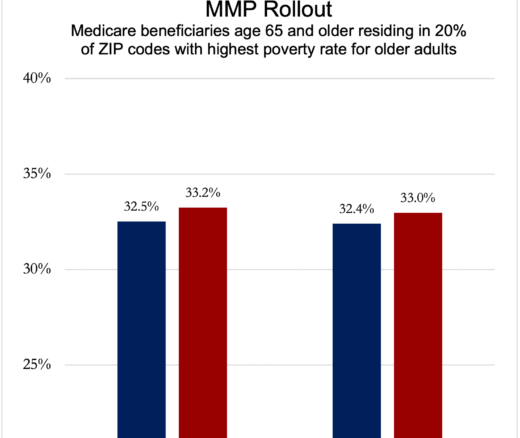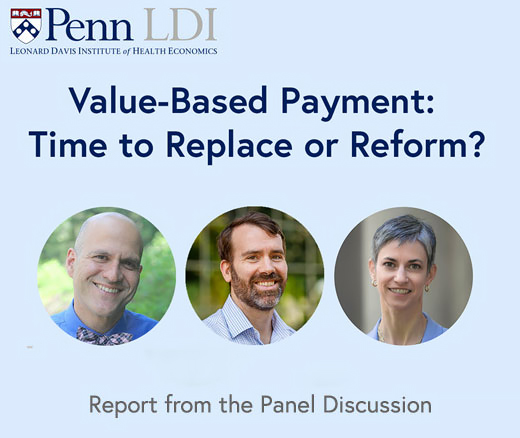
Integrated Care Plans Didn’t Boost Medicaid Enrollment for the Poorest Seniors
Chart of the Day: Medicare-Medicaid Plans—Created to Streamline Care for Dually Eligible Individuals—Failed to Increase Medicaid Participation in High-Poverty Communities
News

Despite the group’s size—67 million—disabled Americans were not recognized by the National Institute on Minority Health and Health Disparities (NIMHD) as an official disparities population until 13 months ago. In its 2023 announcement making that change the NIMHD explained:
“People with disabilities often experience a wide and varying range of health conditions that lead to poorer health and shorter lifespan. In addition, discrimination, inequality, and exclusionary structural practices, programs, and policies create barriers to timely and comprehensive health care, which further results in poorer health outcomes. People with disabilities who also belong to one or more other populations with health disparities fare even worse. NIMHD recognizes the importance and need for research to better understand the complexities leading to disparate health outcomes and multilevel interventions.”
Prior to this official NIMHD designation change, health services researchers focused on disability health issues faced challenges in securing National Institutes of Health (NIH) funding specifically targeting health disparities. But simultaneous with the NIMHD announcement, the NIH opened new funding opportunities for research grants in this area.

One of the leading researchers whose work on this issue was getting national media attention prior to the NIMHD policy change was Tara Lagu, MD, MPH, a Penn alumnus who was the featured speaker at the University of Pennsylvania Leonard Davis Institute of Health Economics (LDI) October 17 annual Samuel P. Martin, III, MD Memorial Lecture.
“People with disabilities are the most extreme example of some of the failures of the health care system, and it is definitely leading to health disparities,” Lagu told the LDI audience. “But when you think about it in a big picture way, it’s like watching the perverse incentives that drive our healthcare care system play out in some of the worst ways possible.”
Lagu, a Professor and Director of Northwestern University’s Institute for Public Health and Medicine’s Center for Health Services and Outcomes Research, initially became interested in the issue of health care access and quality for the disabled 14 years ago. It was the lightbulb moment in her career. She was discharging a female hospital patient but was unable to get a post-discharge urologist appointment for her because she was in a wheelchair.
“‘No, this can’t be. There’s a law,'” Lagu remembered thinking. “I started making calls and found out that I could get a practice to schedule an appointment, but they wanted the wheelchair patient to come in an ambulance and they wanted her transferred to the exam table by an Emergency Medical Services (EMS) worker, which would have cost the family more than $1,000 out of pocket, and the family could not pay that. We couldn’t make an appointment and when leaving, the patient’s daughter looked back at me and said, ‘this is discrimination or something.'”
Shortly after that, without any funding, Lagu organized a team of volunteer medical students and residents to conduct a secret shopper survey of physician practices to determine how many would or would not schedule appointments for patients in wheelchairs. The result was a 2013 paper published in the Annals of Internal Medicine that found that 22% of the practicians surveyed would not schedule wheelchair patient visits. Gynecologists had the highest rate of refusals—44%.
“Some of the called offices said they would be able to transfer the patient to an exam table, but they would have to do it in a way that is considered unsafe,” Lagu said. “One office manager told us, ‘Oh, yes, we can get the patient on an exam table,’ and we asked how they were going to do that. She answered that ‘We’ve got a parking lot attendant and he’s very strong and he’s going to come in and help us.’ For years, we had been seeing qualitative studies about disabled patients who were pregnant being dropped during appointments and stories of hip fractures and suddenly it was becoming clear that those stories were true. We found practices doing all kinds of unusual things. Only about 10% of practices had a height-adjustable exam table.”
“This got us thinking beyond wheelchairs and more broadly about who are people with various disabilities and, overall, how are they being treated in the health care system,” she said. “There are visible and invisible disabilities. There are physical, intellectual, communication, and mental health disabilities. They can be stable. They can be fluctuating. They can be progressive, acute, and chronic. Are they being effectively accommodated throughout the health care system or are they, too, leaving an office thinking or saying, ‘this is discrimination or something.'”
Lagu has focused on disability disparities ever since and become a nationally recognized authority in the field. Featured in major articles in the New York Times and The Atlantic magazine, her 2022 study published in HealthAffairs, detailed the results of focus group sessions with physicians across the country who were granted anonymity in return for frank discussions about their attitudes and practices related to people with disabilities. In her New York Times comments, Lagu said she was “shocked” by the level of callous attitudes and operational bias against disabled patients expressed by many of the doctors.
The focus-group responses identified several barriers to providing care for people with disabilities: physical accommodations; communication accommodations; knowledge, experience, and skills; structural barriers; and attitudes toward people with disabilities. Examples from the study include:
Lagu emphasized the lack of adequate training in the care of the disabled in health care facilities across the country as well as in the schools that train their doctors, nurses, technicians, and aides.
“We need to educate our health care workforce how to provide access and care for people with a wide range of disabilities,” Lagu said. “That means you have to have an exam table big enough and adjustable enough, and room next to the exam table for transfers, along with an accessible route in and out of your building, and a bathroom. You have to have sign language interpreters and telecommunication devices available to help you communicate with people with communication and hearing disabilities.”
“The access and care for people with disabilities is not just about providing accommodations in the moment, but also about having a programmatic way to provide knowledge to your staff that the person is coming in and what their accommodations needs are, so you have a room reserved that has the appropriate equipment and support services,” she said.
The findings of both NIMHD and Lagu’s studies make clear the need for a broad range of new research to fully define adequate practices, protocols, interventions, and funding policies for the care of this underserved population. However, Lagu pointed out that the lack of data currently makes it impossible to conduct much of that research.
“The thing that’s become very clear is that we have to improve our data,” Lagu said. “For the purposes of data collection and health care, I want us to now think of disability as a demographic characteristic. We’ve collected information on race in healthcare settings since 1977 and have been able to describe disparities in access for people who are racial minorities because the data were there. We can’t do those same studies for disability because the data are not currently there,” Lagu said.
“Neither disabilities nor accommodation needs are documented in the electronic health record (EHR),” Lagu continued. “In comparison, think about the allergy examination example—we document allergies aggressively because we’re scared about that. We don’t do that with disability accommodation needs and, as a result, we don’t know what our patient needs are. No wonder we find it difficult to care for that patient appropriately. We currently have a study underway focusing on both how to get disability and accommodation data into the EHR, and then how to add that to the clinical workflow.”
“The other thing we need is policy change,” said Lagu. “Because if we’re not required to collect the data, not every hospital system is going to do it, and I think we have to have a standardized way to collect the data so that we can then do the studies that actually identify where the gaps in care are. There’s an entire field of research waiting to be done if we would just collect the data.”


Chart of the Day: Medicare-Medicaid Plans—Created to Streamline Care for Dually Eligible Individuals—Failed to Increase Medicaid Participation in High-Poverty Communities

Penn LDI Debates the Pros and Cons of Payment Reform

One of the Authors, Penn’s Kevin B. Johnson, Explains the Principles It Sets Out

Six Lessons the U.S. Can Learn from Europe About Protecting Health Data Linkages

Moving from Fee-for-Service to Risk-Based Contracts Hasn’t Dramatically Changed Patient Care, Raising Questions About How to Make These Models More Effective

Equitably Improving Care for Hospitalized Kids Who Experience Cardiac Arrest Requires Hospital-Level Changes, LDI Fellows Say